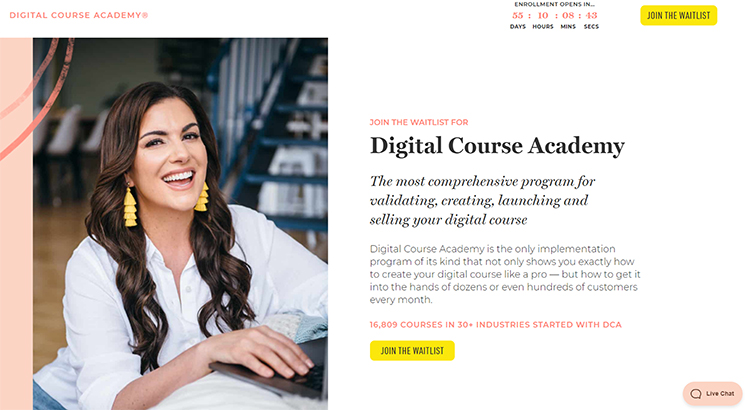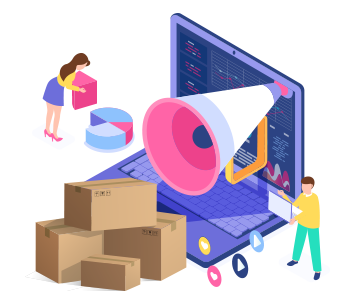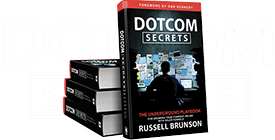If you’re wondering how you can promote a product to your existing customers, then you’re already on the path to success.
- Existing customers are 50% more likely to try your business’s new product.
- The probability of selling to an existing customer is between 60% and 70%.
- Existing customers are also 31% more likely to spend more on their average order value with your business.
- The average, loyal customer spends 67% more in their 31st to 36th month with a brand than in their first six months of the relationship.
i.e. your existing customers — the ones who’ve bought from you before — are one of your most profitable assets.
Of course, the how is just as important as the who.
How you promote a product to your existing customers has a big impact on the success of your promotions — How many emails do you send? What do you say? When do you start promoting a product before it launches?
Below, we’re going to show you the most effective strategy we know of for promoting a product to a company’s existing customers.
It’s called the Product Launch Funnel (<– click that link to get your free Product Launch Funnel now).
Learn How To Build High-Ticket Sales Funnels Now (For Free)!
Understanding the Product Launch Sales Funnel
At ClickFunnels, we’re something of specialists in crafting sales funnels — page-by-page experiences that guide people, one baby step at a time, toward seamless conversion.
And one of our favorite sales funnels for promoting a product is our Product Launch Funnel…

As you can see, this sales funnel traditionally consists of 6 phases…
- Squeeze Page — For collecting interest.
- Survey — For pre-qualifying.
- Product Launch Page 1 — For building excitement/anticipation.
- Product Launch Page 2 — For building excitement/anticipation.
- Product Launch Page 3 — For building excitement/anticipation.
- Product Launch Order Form — For making sales.
Now to be clear, this Product Launch Funnel takes place over weeks or even multiple weeks — and you could technically even have as many “Product Launch Pages” as you want.
First, people will show interest in your upcoming product by opting in on your Squeeze Page — that way you can create an email segment of interested customers.

Then those people will be prompted to take a short survey so that you can pre-qualify them.

And finally, those people will arrive at your 1st Product Launch Page — this page will go into a little more detail about your upcoming product and get people excited to buy.

That’s the end of the first phase.
Then over the next few weeks, you send emails (see “Follow-Up Funnels” below) to your new segment that guide them toward new content (i.e. Product Launch Pages) which is crafted to build excitement and anticipation for your product launch.
Those could be video or blog posts or dedicated pages.
In the Product Launch Funnel, a lot of effort goes into building excitement and anticipation for the actual launch of your product — that is, you promote your product before you sell it.
This gives your launch day a bigger chance of success by allowing you to pre-sell people. And by the time you open the gates, people are already convinced to buy.
We’re going to walk you through the details of creating a Product Launch Funnel below (you can create a free ClickFunnels account to start building your funnel right away). But before we do that, you need to understand something we call Follow-Up Funnels.
A Quick Caveat
To be clear, our Product Launch Funnel is typically used to promote high-ticket offers to your existing customers — that’s why there is so much work put into creating anticipation and building value.
If you just want to promote a no-brainer low-ticket offer to your existing customers, then there’s no reason to be shy! Send ‘em an email like Jon Morrow does…

If you need to spend more time explaining the value of your product, however, then use the Product Launch Funnel instead — we’ll explain the details of how to do that below!
Understanding Follow-Up Funnels
As we mentioned above, unlike most sales funnels, a Product Launch Funnel takes place over multiple weeks.
How?
By sending emails as a part of your Product Launch Funnel which drives your customers toward learning about — and eventually, buying — your product.
And so you’ll need to craft Follow-Up Funnels as well — these are just prebuilt email sequences that trigger alongside your Product Launch Funnel to drive people to the right pages at the right time.
When your Product Launch Funnel is working well with your Follow-Up Funnel, the entire thing should look something like this…
7. Phase 1 – Email To Guide Existing Customer Toward Squeeze Page
a. Squeeze Page
b. Survey
c. Product Launch Page 1
8. Phase 2 – Email To Guide New Segment Toward Next Product Launch Page
a. Product Launch Page 2
9. Phase 2 Cont. – Email To Guide New Segment Toward Next Product Launch Page
a. Product Launch Page 3
10. Phase 2 Cont…
a. …
11. Phase 3 – Email To Guide New Segment Toward Final Product Launch Order Form
a. Product Launch Order Form
Since we’re talking about promoting a product to existing customers, traffic is driven entirely via email — because you already have your customer’s email addresses.
But it then transitions to specifically target people who show interest in your upcoming launch during Phase 1 — so that you’re not bombarding people with email who aren’t interested in your new product.
Now let’s dive into the details and look at some awesome examples.
Step 1. Collect Interest
The first step is to announce your upcoming product to your existing customers via email and send them to a landing page where they can join a “waitlist” or sign up for future updates and announcements.
On the backend, opting in should simply add the subscriber to the segment you’re using for your product launch — that could be a separate tag or list (depending on the software you’re using).
As an example of what your initial product launch page might look like, check out Amy Porterfield’s landing page for her Digital Course Academy (a high-ticket program where she teaches people how to build and sell online courses)…

The full page is long and includes a decent amount of detail, but you could just simplify things for your first Product Launch Page and do a no-scroll page that looks something more like this…

(By the way, if you want to learn how to write awesome copy for your sales pages, get a free copy of our book, Copywriting Secrets)
The goal here is just to build curiosity around your upcoming launch and get people to opt-in to your email list where you’ll be explaining more details about the product.
Your CTA could be something like…
- Join The Waitlist!
- Sign Up For Updates!
Or…
- Be The First To Know More!
Here’s an example of what your first promo email might look like (it should be short, sweet, and curiosity-inducing)…
Hey!
I’ve been cooking something up for the last few months… something that will help you MASSIVELY with generating high-quality leads for your business for very little money (I’m talking about as little as $0.50 for quality leads).
But you’ve been a loyal customer.
And I want to make sure that you see this before everyone else.
But I also don’t want to bombard you with emails that you don’t want to receive.
So look — if you want to be the first to hear about what I’ve got cooking, sign up over here for updates.
Wishing you the best,
Mike
Step 2. Create a Simple Survey (Optional)
Once people visit your first Product Launch Page, you have the option of sending them to a survey where you can collect more information about them.
This is an optional step but it can be useful for several different reasons.
- If you’re trying to learn about your target market and what they want.
- If you want to pre-qualify people for your high-ticket offer.
- If you want to gauge the level of interest in your upcoming offer.
Here are some questions that you might consider asking depending on your goal with the survey…
- How excited are you for this upcoming product?
- What do you think would be a fair price for this product?
- What’s your average monthly income?
- What problem do you want to solve with this product?
- How exciting do you think this offer would be to your friends?
- What would keep you from purchasing this when it launches?
You can even use the information you collect from your survey to craft your upcoming Product Launch Pages.
Step 3. Build Anticipation
After your segment has shown interest (by opting in) in your upcoming product, over the next few weeks before you launch, it’s time to target those people with emails and Product Launch Pages that build anticipation and excitement for launch day.
The “Pages” don’t necessarily have to be pages, though — they might be blog posts or Facebook Live videos or some other type of content that expounds on your upcoming offer.
Let’s look at some examples from Amy Porterfield’s launch of Digital Course Academy.
In the following email, her “Product Launch Page” is simply a Facebook Live video where she interviews past clients she’s worked with and addresses possible objections people will have to join Digital Course Academy…

In another email that’s part of the same sequence, she created a video with a “pep talk” to help build excitement for Digital Course Academy and convince people to convert…

And in this email, she gives a sneak peek into the content of her upcoming webinar (where she sells Digital Course Academy)…

As you can see, there are a lot of different creative ways to craft the anticipation-building part of the sales funnel. You could…
- Run a Webinar
- Write Blog Posts
- Interview Other Experts
- Do Facebook Live Videos
- Give Pep Talks
- Etc.
The goal is to provide free value for your list and talk about your upcoming product launch so people get excited to buy.
The important thing is that you outline what you’re going to send and when you’re going to send it so that things don’t get jumbled during your promotion.
By the way, if you want to learn how to sell high-ticket products with sales funnels without talking to people on the phone, then go here (we’ve got a gift for you).
Step 4. Consider a Pre-Launch
Okay — at this point you’ve announced your upcoming product and spent a few weeks building anticipation and excitement around the upcoming launch.
As a little gift to your subscribers (and to increase conversions), you might consider doing a pre-launch where you sell the product only to past customers for a discounted price.
However, we only recommend doing this if once the product is launched, it doesn’t go away.
The entire point of doing a pre-launch is to create urgency so that your list purchases before the discount ends — but if the doors already close at a certain time, then additional urgency is probably unnecessary.
If you do decide to do a pre-launch discount to create urgency, then we recommend doing it for just one to three days — and make sure you email every day about it! Most people will buy right before the doors close.
Here’s an example of an email you might send for the pre-launch…
Are you excited for the launch of my Sell Everything Easily course?
Well I’ve got some top-secret news for you…
For you — my customer — the doors don’t open in three days (like they do for everyone else).
Nope.
They open TODAY.
And they open with a 20% discount only available to my loyal customers.
But you better hurry — I’m only leaving these doors open for 48 hours.
Click here to claim your special discount and change your business forever.
Learn How To Build High-Ticket Sales Funnels Now (For Free)!
Step 5. Expect Sales on The Final Day
We talk about creating urgency a lot at ClickFunnels…
But that’s because urgency is really powerful.
Just consider some of the following science-backed suggestions from Business 2 Community…
- Urgency words used in emails will engage and excite customers for your promotions.
- Boost your opt-in rates by keeping enrollment periods or trial periods short.
- Visual symbols, like a countdown timer, raise the urgency level and drive actions.
With our own testing here at ClickFunnels, we’ve found all of those suggestions to be useful.
But here’s another thing.
People are procrastinators.
We’ve found — and so have many other marketers that we know — that when an offer includes urgency, most people will buy at the last minute.
Here’s an example.
Whenever a friend of mine — Jacob McMillen — runs a promotion, the vast majority of the people buy on the day the doors close (in this case, August 16th)…

The point here is about managing your expectations.
You might think that your customers are all going to sign up and buy right away, with just a single email — they’ve bought from you before, after all!
But that’s not the case.
This stuff takes time.
And that’s why we’re placing so much emphasis on building anticipation and excitement for your official launch.
Ultimately most people will procrastinate and buy at the last second — so email multiple times on the final day of your offer (if there is one) and pull out all the stops (free bonuses, details about value, testimonials, etc).
Check out this Amy Porterfield email for inspiration…

Step 6. Close The Doors
Maybe you’re offering a product that you don’t want to close the door on — maybe it’ll be a core offer that sticks around all the time.
If that’s the case, we recommend the pre-launch (point 4) for making launch day a success.
HOWEVER…
If you’re able to close the door on your offer and make it available only for a limited time, then we recommend doing so — you can re-launch every 3 or 6 months.
This is often a more profitable way to run your offers because it creates natural demand, scarcity, and urgency for your customers.
So don’t be afraid to say, “Time’s up.”
Final Thoughts
Your customers are your most valuable asset.
So it’s a good idea to promote products to them — they’ll be easier to sell to than new customers and they’ll likely spend more money when they purchase.
But how do you sell to your customers effectively?
Above, we’ve walked you through our 6-step Product Launch Funnel.
Collect interest, create a survey, build anticipation, consider a pre-launch, expect final-day sales, and close the doors.
Those tips should set you on the path to success.
And click below if you want to learn how to build high-ticket sales funnels in more detail!
Learn How To Build High-Ticket Sales Funnels Now (For Free)!


